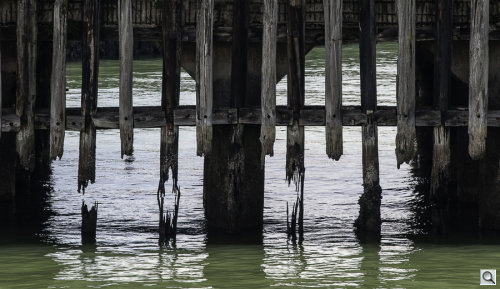Photo Corners headlinesarchivemikepasini.com
![]()
A S C R A P B O O K O F S O L U T I O N S F O R T H E P H O T O G R A P H E R
![]()
Enhancing the enjoyment of taking pictures with news that matters, features that entertain and images that delight. Published frequently.
Friday Slide Show: Pier Pilings




22 March 2019
Nothing lasts forever, we are constantly reminded. That's one reason we welcome spring each year. It counters the continual decay we confront every day with a new bud, a blossom, a fence going up, the painters arriving.
On our visit to Fort Mason last weekend, we toured the Ttozoi: Genius Loci exhibit at the Museo Italo Americano. Genius loci is Latin for guardian spirit or soul of a place, the curator informs us.
That's what Stefano Forgione and Giuseppe Rossi had in mind when they came up with the pseudonym Ttozoi to create "works of art in situ at select historical sites, using the original technique of the natural proliferation of molds on jute, with pictorial intervention by the artists."

Pier 3. Concrete pilings now support all the piers, as seen under the Festival Pavilion to the east here.
The paintings on display were created at two of Italy's UNESCO World Heritage sites:
- The Royal Palace of Caserta with its Necropoli Sannita dating back to the 4th century BC
- The amphitheater in the Archeological Park of Pompeii, as well as in Rome's ancient Jewish Ghetto.
A future phase of the project is currently being planned for the Roman Colosseum.
The exhibition notes explain their process:
The artists simultaneously paint a jute canvas with an organic substance made up of natural pigment, water and a variety of flours. They then seal the work in a case, store the case on site for a period of up to several months and allow the molds to proliferate naturally. Inside the case, the molds feed on the organic material, interacting with the work of art and creating their own haphazard paths and designs through the veins of the jute. The artists closely monitor the progress of the spores and decide when it is time to interrupt it. The canvases are then cleaned and sealed with resins, used for the purpose of protecting the work without altering the naturalness of the result.
These collaborative works with the remains of the past are "signed" with what look like two little red fingers of different lengths along the bottom edge of the canvas.
We must have been under their influence as we walked back off Pier 2 and, looking across at Pier 1 to the west, noticed the old wooden pilings.

Pier 1. Close-up of the pilings.
They do not, we suspect, date to the original construction between 1909 and 1912. Perhaps they date from World War II when business was brisk supplying transport ships with materials for bases being built in Hawaii, the Philippines and other Pacific islands before becoming a troop transport station.
We weren't able to dig up any history on them but it's clear they are history. Our World Heritage equivalent. Even if they have been functionally replaced with concrete pilings.
They are barnacled and eaten away and left to rot. And they make a statement about foundations and decay we found compelling in their variation of form and shared destiny. They had failed, but each failure was unique.
So we thought of a series of photographs. We took three approaches: a wide angle, a medium shot and close-ups. We tried them all together and in the three individual sets. We liked the medium shots the best.
We also tried a variety of crops, leaving in a hint of the building above, for example. But in the end, we preferred the simpler composition of just the colorless wood and the hues of the bay.
It's a depiction of the decay that eats away at things, almost unnoticed, in short, until it is too late to avoid anything but the heritage of collapse. A reflection the times perhaps.
